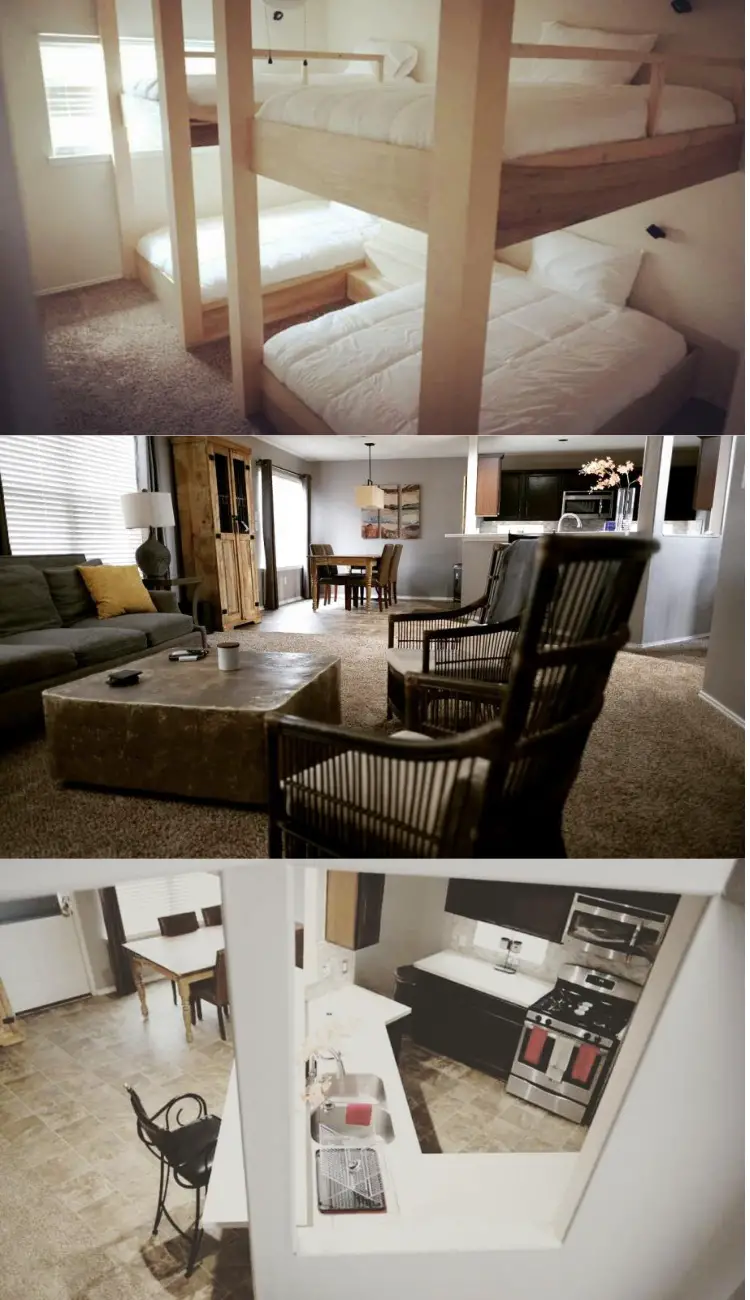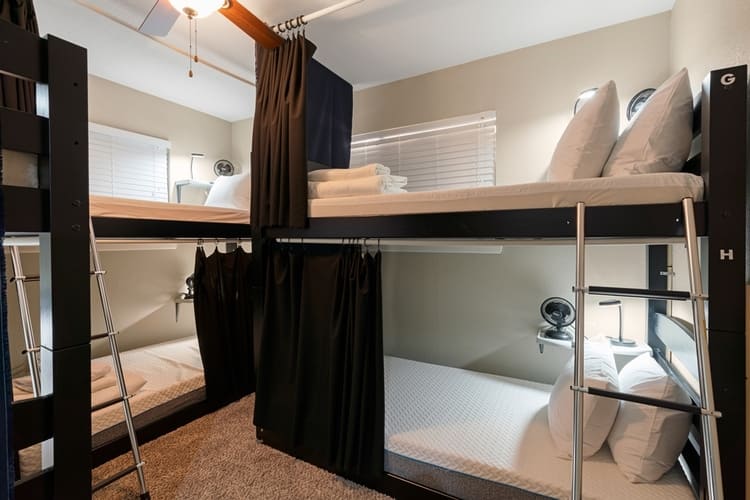If you are new to the airline industry, you may have overheard crew members talking about “crash pads,” and probably wondered what on earth they were talking about. Isn’t it taboo to say “crash” on an airplane?
Not to worry, a crash pad is where flight crew “crash,” (as in sleep), before, after, or between trips. They are intended to give crew members who don’t live in the same city as their base airport a cheap place to sleep.
This guide will explain everything you need to know about crash pads.
Table of Contents
What Is a Crash Pad?
A crash pad is a house or apartment shared by multiple crew members.
Since crash pads are not intended to be someone’s main residence, the sleeping rooms are filled with multiple beds that are individually rented out to give commuters a cheap place to sleep before or after a trip.
Types of Crash Pads
There are two types of crash pads:
1) Cold bed
In these types of crash pads, each crew member rents a sleeping space, usually a bunk bed, that is theirs, and only theirs, for the duration of the rental contract.
These types of crash pads are usually owned and operated by other airline employees, or a crash pad agency.
The advantage of a cold bed is that you can usually leave some of your stuff in the space, like your uniforms, when you are not there.
These crash pads usually have a kitchen that you can use. You will also have more of a sense of community as you will likely get to know the other crew members living in the crash pad.
The cons of a cold bed crash pad is that you generally will need to provide your own bed linens, and may be asked to participate in some upkeep chores to maintain the space.
Rent is charged monthly.

2) Warm bed
In these types of crash pad, crew members reserve a bunk night-to-night.
When they aren’t using the bed, someone else is.
These types of crash pads are usually run by an agency or hotel.
The advantage of a warm bed is that you usually only have to pay for the nights you actually stay in the crash pad, a housekeeping service is provided daily to switch-out bed linens between people, so you don’t have to worry about providing your own.
The cons of a warm bed include, not being able to leave your stuff in the space, generally not having access to a kitchen, and you may never really get to know the people you share the space with.
Personal Side Note: When I was flying, I stayed in a warm bed crash pad. It was located inside a Hyatt House hotel, which was great because I also got free breakfast!
Who Are Crash Pads For?
Crash pads are for airline employees, including pilots, flight attendants, and even mechanics.
Though most crash pads are segregated by work group, some crash pads can be for both pilots and flight attendants.
Some crash pads may even be exclusively for flight attendants of a single airline.
I know of many crash pads that were owned by AA flight attendants, and were only available to AA flight attendants.
Why Is a Crash Pad Useful for Flight Attendants?
Crash pads are useful for flight attendants who choose not to live in the same city as their base airport.
These crew members, also known as “commuters,” may need a place to “crash” before, after, or between trips.
When Is a Crash Pad Useful?
Crash pads are really useful in a handful of situations, including:
- Before trips: If you have an early report time, you may need to commute in the night before your trip, and you will need a place to stay.
- After trips: If a trip ends after your last possible flight home, you will need a place to crash until the next morning, so you can catch that first flight back to your “commuter city.”
- Between trips: If you have back-to-back trips, it tends not to make sense to commute all the way home. Crash pads give you a place to spend the night, re-pack, and maybe even meal prep between trips.
- On reserve: Being on reserve as a commuter is stressful because you are required to be “in base.” It is often too risky to try to commute after you are given an assignment, so commuters will tend to wait out reserve in a crash pad.
Pros of Staying in a Crash Pad
If you are a commuter, or thinking about becoming a commuter, there are plenty of pros to staying in a crash pad.
- Cheaper than staying in a hotel all the time. If you have to spend more than a couple of nights in your domicile (aka airport city) it will save you money long-term to stay at a crash pad.
- You can leave things in the crash pad. If you rent a cold bed, you can leave your uniforms at the crash pad, so they’re always there where you need them.
- You can meal prep. If your crash pad has a kitchen, you can use it to meal prep between trips, or at least cook for yourself rather than eating out or in a hotel, which also saves you money long-term.
- You have a community. Especially when you rent at a cold bed crash pad, you will likely get to know your fellow pad-mates and build a sense of community, which is really helpful in a career that can sometimes get quite lonely.
Cons of Staying in a Crash Pad
There are some cons to staying in crash pads.
- No personal space. There is really no personal space to be had in crash pads. They can be quite crowded at times.
- Noisy: If you are a light sleeper, it might be very difficult for you to get quality shut-eye in a crash pad because people are coming and going at all hours of the day.
- Not always secure: Some crash pads can be located in unsafe areas.
Crash Pads Compared to Hotels
Crash pads and hotels are two options for commuters. If you are trying to decide if a crash pad is right for you, this table comparing them to hotels might help.
| Crash Pads | Hotels |
| Rent: $200-$500 per month | Price: $50-$200 per night (with discount) |
| Getting to the airport: public transit | Getting to the airport: shuttle |
| Food cost: Meal prep/ cook yourself ($) | Food cost: Hotel Restaurant ($$$) |
| Shared space | Personal space |
| Guaranteed spot | May run out of vacancies |
Of course, hot bed crash pads operate a little more like hotels in this case.
But their nightly price tends to be $15-30 a night.
So still significantly cheaper than renting your own hotel room.
Tips on Finding a Crash Pad
The best way to find a crash pad is to check the community boards in the crew rooms at your base.
Most crash pads, especially those owned by other crew members, will advertise vacancies on these info boards.
Another great place to look is Facebook. Most airline bases will have Facebook groups, these are usually airline specific, but they will feature ads for crash pads that have vacancies.
When searching, also try writing crash pad as a single word, “crashpad.”
For example: “CLT Crashpads.”
Otherwise, ask around while you’re on the jumpseat.
Word of mouth is one of the best ways to find a crash pad. Especially since gossip about bad crash pads travels fast.
By asking people who have been commuting to your base for a while, you’ll likely learn which crash pads to avoid, and which are the most sought out.
If this doesn’t work, turn to the internet!
Crashpad Websites
There are websites that advertise and list crash pads. To use these websites, all you have to do is enter the airport code of your base airport, and go through the listings to find one that matches your needs.
One nice feature of these websites is the ability to filter your searches.
Here are a few links to these websites:
- Crash Pad 411: this site features mostly privately owned crash pads. Both hot and cold bed crash pads can be found on this site. As well as private rooms in a shared home (belonging to flight attendants or pilots).
- Pure Crashpads: this site advertises crash pads, single rooms in a shared apartment, and month-to-month furnished apartment rentals. So, just be aware, this site isn’t showing you only crash pads.
- Hotel Crash Pads: This website shows only crash pads that are located in hotels. Keep in mind, most hotel crash pads are run by an agency that has an agreement with the hotel to have certain rooms act as crash pads. It offers a few subscription levels.
- Flight Crew Relocation Service: This service, established in 1997, may be one of the first crashpad registries. (And you can tell from its website). You need to become a member first, but this service comes recommended by airline unions and senior flight attendants, so it is a safe bet.
- Crashpads DFW: This site is for DFW-based airline employees only.
- Crew Crash Pads: This site offers hotel crash pads in nine different cities.
The Crash Pad App
The crash pad registry, Crewmates, has developed an app to help airline employees find crash pads.
You can download the app and browse crash pads by base. You do need to create a user account first, though.
Or, you can visit their Instagram, and click on the link tree in their bio. Which takes you to a listing of Facebook groups for various bases. These groups also advertise crash pads with vacancies.
There are a few unique features offered in the app that, I think, are very helpful:
- Rent payments are made within the app.
- All renters are verified as members of the airline industry.
- There is a crash pad quiz to help you determine which type of crash pad will be best for you.
Frequently Asked Questions
I will close out this guide by answering some FAQs about crash pads. If your question was not answered, feel free to ask us!
➡️ Where are crash pads usually located?
Crash pads are usually located close to the airports where flight attendants and pilots are based.
These tend to be in bigger cities where rent is quite expensive, so crash pads give flight attendants, especially, the opportunity to live somewhere else and commute to work.
➡️ How much does a crash pad cost?
Crash pads typically cost between $200 and $500 a month for rent.
Hotel crash pads, that charge per night, will usually run you $20-50 a night.
This is still much cheaper than staying in a hotel, even if those hotels offer airline discounts or “commuter” rates.
➡️ Is it only for flight attendants, pilots and airline staff?
Yes, crash pads are only for flight attendants, pilots, and sometimes other airline employees, like mechanics.
Most of the time, you will need to verify your employment status by presenting your crew ID.
If you are still in training, your CJO should be accepted pending your graduation.
➡️ What amenities are typically included in a crash pad?
Most crash pads will offer you a bed, (typically a bunk bed), a kitchen, and a bathroom.
Hotel crash pads, will likely not give you access to a kitchen, but will probably grant you a discount to their restaurant. Some will have shuttles to the airport, others will be close to public transit.
➡️ Are there any rules or restrictions for staying in a crash pad?
Yes, most crash pads prohibit you from using the crash pad as your permanent residence.
To enforce this, you are usually only allowed to stay there 5–6 nights at a time.
Otherwise, each crash pad will set rules regarding chores, kitchen maintenance, and what you can leave in the space while you aren’t there.
➡️ How do I know if a crash pad is a good fit for me?
Sometimes it is a matter of trial and error. If you are having trouble deciding between a cold or a hot bet crash pad, I recommend taking the crash pad quiz.
Ultimately, you should be able to reach a good decision based on the location you want to be in, the people you hope to share the space with, and how much you want to pay.
➡️ Can I bring guests to a crash pad?
It depends on the rules of the crash pad.
Some allow you to have guests, others do not.
Most do not allow you to have overnight guests.
The best way to find out is to ask.
If having guests is important to you, make sure you find out the policy before you commit to a contract!
➡️ What is the typical length of stay in a crash pad?
Most flight attendants will only stay a night or two at a time.
However, if you are on reserve and don’t get an assignment, you may end up spending up to 5–6 nights in a row in your crash pad.
If you think you will be spending more than a night or two, it’s best to get a cold bed.
➡️ Are there any safety concerns with staying in a crash pad?
Crash pads tend to be safer than hotels.
Everyone you are sharing the space with is also an airline employee who has had to pass an extensive background check.
However, crash pads are not always located in the safest neighborhoods. And petty theft does occasionally occur between pad mates, but this is rare.
Conclusion
Crash pads are a part of airline life. If you are a commuter, you will probably end up staging in a crash pad at some point during your career.
I hope this guide has helped you understand what a crash pad is, and point you towards some useful resources for finding a crash pad that fits your needs.




